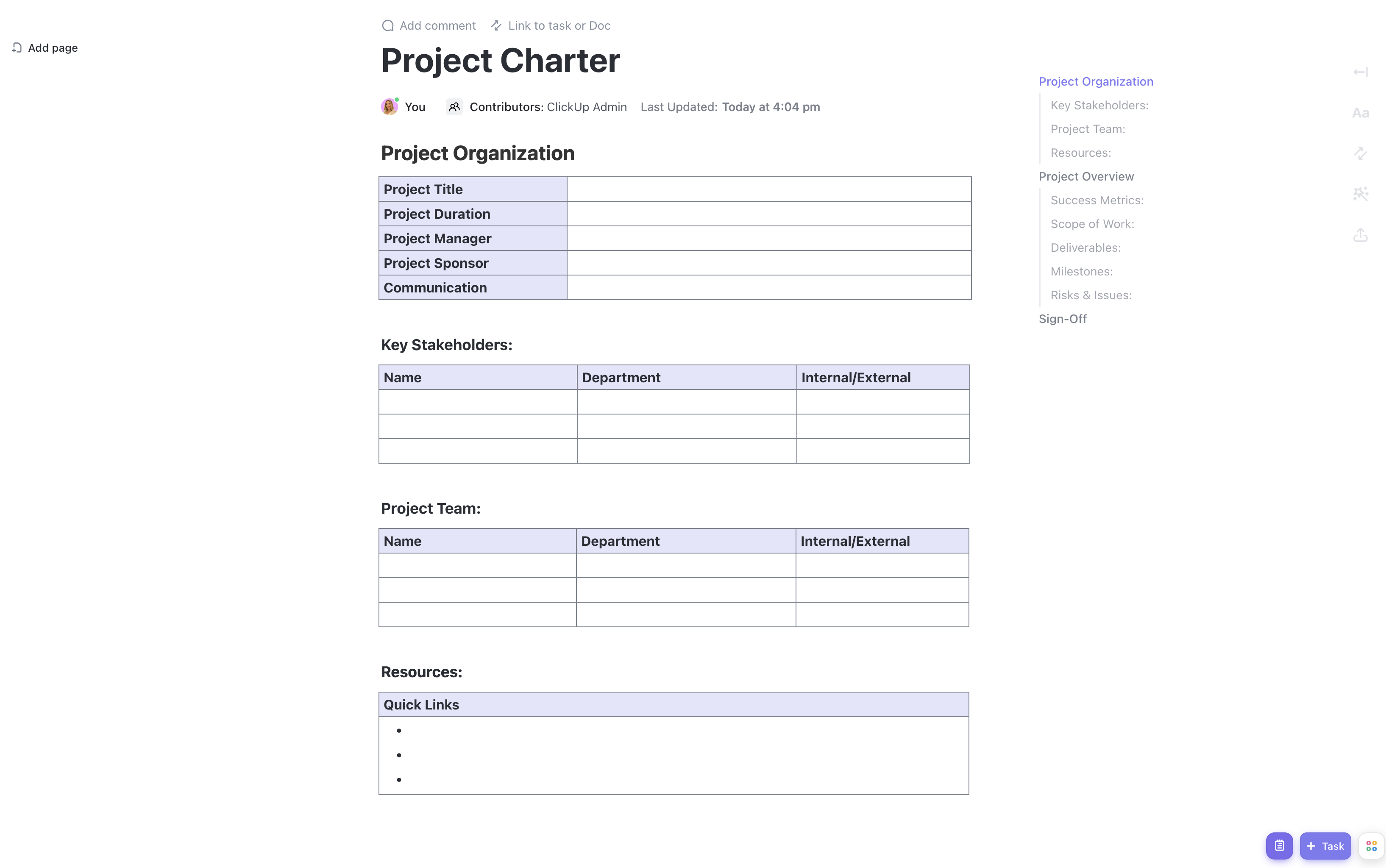Managing properties can be a complex endeavor, requiring careful planning, organization, and collaboration. To ensure smooth and successful property management projects, you need a comprehensive project charter that covers all the essential details. That's where ClickUp's Property Management Project Charter Template comes in!
With ClickUp's Property Management Project Charter Template, you can:
- Define project objectives, scope, and deliverables
- Outline roles and responsibilities for your property management team
- Set realistic timelines and milestones to keep your project on track
- Identify potential risks and develop mitigation strategies
- Establish clear communication channels and reporting procedures
Whether you're managing residential or commercial properties, this template will help you streamline your property management projects and achieve your goals efficiently. Get started with ClickUp today and take your property management to the next level!
Benefits of Property Management Project Charter Template
When it comes to property management projects, having a clear plan is essential. The Property Management Project Charter Template offers numerous benefits, including:
- Streamlining project initiation by providing a structured framework
- Ensuring all stakeholders are aligned on project goals and objectives
- Facilitating effective communication and collaboration among team members
- Helping identify potential risks and develop mitigation strategies
- Providing a roadmap for project execution and monitoring progress
- Enhancing accountability and ensuring project deliverables are met on time
- Improving overall project efficiency and success rate.
Main Elements of Property Management Project Charter Template
ClickUp's Property Management Project Charter template is the perfect tool to streamline your property management projects. Here are the main elements of this Doc template:
- Custom Statuses: Track the progress of your property management projects with custom statuses tailored to your workflow.
- Custom Fields: Utilize custom fields to capture important information such as property details, tenant information, maintenance schedules, and financial data.
- Different Views: Access multiple views to visualize and manage your property management projects effectively. Use the Board view to track tasks and progress, the Calendar view to schedule maintenance and inspections, and the Table view to analyze financial data and track expenses.
With ClickUp's Property Management Project Charter template, you can centralize all your property management information, collaborate with your team, and ensure smooth operations.
How to Use Project Charter for Property Management System
If you're embarking on a property management project, using a Project Charter template can help you effectively plan and execute your project. Here are four steps to use the Property Management Project Charter Template:
1. Define the project scope and objectives
Start by clearly defining the scope of your property management project. What specific tasks and goals do you want to accomplish? Are you focusing on property renovations, tenant acquisition, or financial analysis? Clearly outline your project objectives and ensure they align with your overall business goals.
Use Goals in ClickUp to define and track your project objectives, ensuring everyone is on the same page.
2. Identify project stakeholders
Identify the key individuals or groups who have a vested interest in your property management project. This can include property owners, tenants, contractors, and other relevant parties. Understanding and involving all stakeholders from the beginning will help ensure their needs and expectations are met throughout the project.
Create custom fields in ClickUp to track and organize your project stakeholders, making it easy to communicate and collaborate with them.
3. Develop a project timeline and milestones
Create a timeline for your property management project, outlining the major milestones and deliverables. This will help you stay on track and ensure that tasks are completed in a timely manner. Consider factors such as property inspections, tenant onboarding, and ongoing maintenance to create a realistic and achievable timeline.
Use Gantt charts in ClickUp to visualize your project timeline and milestones, making it easy to monitor progress and adjust as needed.
4. Assign responsibilities and resources
Assign specific responsibilities to team members involved in the property management project. Clearly define roles and ensure that each person understands their tasks and deadlines. Additionally, identify the necessary resources, such as budget, equipment, and materials, needed to successfully complete the project.
Use tasks and subtasks in ClickUp to assign responsibilities and track progress, ensuring that everyone knows what they need to do and when.
By following these steps and utilizing the Property Management Project Charter Template in ClickUp, you'll be able to effectively plan and execute your property management project, leading to successful outcomes and satisfied stakeholders.

Get Started with ClickUp's Property Management Project Charter Template
Property managers and real estate professionals can use this Property Management Project Charter Template to streamline the management of their properties and ensure smooth operations.
First, hit “Get Free Solution” to sign up for ClickUp and add the template to your Workspace. Make sure you designate which Space or location in your Workspace you’d like this template applied.
Next, invite relevant members or guests to your Workspace to start collaborating.
Now you can take advantage of the full potential of this template to manage your properties:
- Use the Portfolio View to keep track of all your properties and their key details
- The Lease Schedule View will help you manage lease agreements and ensure timely renewals
- Use the Maintenance Requests View to track and address any maintenance issues reported by tenants
- The Financial Overview View will help you monitor income, expenses, and financial reports across properties
- Organize tasks into different statuses to keep track of progress, such as Vacant, Occupied, Maintenance, and Payment
- Regularly update status to keep stakeholders informed of progress and take necessary actions
- Monitor and analyze property performance to ensure efficient operations and maximize returns.









